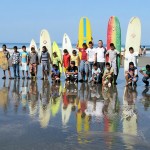San Luis Talpa: from pesticide-contaminated town to inclusive surf city
In the 1960s, El Salvador began to import chemical pesticides and fertilizers heavily in order to increase agricultural yield. In practice that meant El Salvador became the dumpster for many of the chemical pesticides that were banned in the United States and Europe. Chemicals, such as Agent Orange used in the Vietnam War, found their […]

 In the 1960s, El Salvador began to import chemical pesticides and fertilizers heavily in order to increase agricultural yield. In practice that meant El Salvador became the dumpster for many of the chemical pesticides that were banned in the United States and Europe. Chemicals, such as Agent Orange used in the Vietnam War, found their ways into El Salvador, branded under different names. Cotton and sugarcane cultivations were the major crops raised for export and farmers bought into the benefits of chemical fertilizers and pesticides in the 1960s. So their usage continued for years and years with no regulation. And as long as money was made, everyone was happy. Over the years, the sugar cane cultivation thrived while the cotton cultivation slumped due to competitions in international markets around the mid-1970s. Around 1995, the first reports of people dying from kidney failures started to emerge. In 2001, a well-known Salvadoran scientist became convinced that there was a relation between pesticides and kidney failures. He went to the Legislative Assembly to ask the government to ban a list of pesticides. His words were ignored, and he was dismissed as a mad scientist.
In the 1960s, El Salvador began to import chemical pesticides and fertilizers heavily in order to increase agricultural yield. In practice that meant El Salvador became the dumpster for many of the chemical pesticides that were banned in the United States and Europe. Chemicals, such as Agent Orange used in the Vietnam War, found their ways into El Salvador, branded under different names. Cotton and sugarcane cultivations were the major crops raised for export and farmers bought into the benefits of chemical fertilizers and pesticides in the 1960s. So their usage continued for years and years with no regulation. And as long as money was made, everyone was happy. Over the years, the sugar cane cultivation thrived while the cotton cultivation slumped due to competitions in international markets around the mid-1970s. Around 1995, the first reports of people dying from kidney failures started to emerge. In 2001, a well-known Salvadoran scientist became convinced that there was a relation between pesticides and kidney failures. He went to the Legislative Assembly to ask the government to ban a list of pesticides. His words were ignored, and he was dismissed as a mad scientist.
See the original article here:
San Luis Talpa: from pesticide-contaminated town to inclusive surf city

Comments are closed.